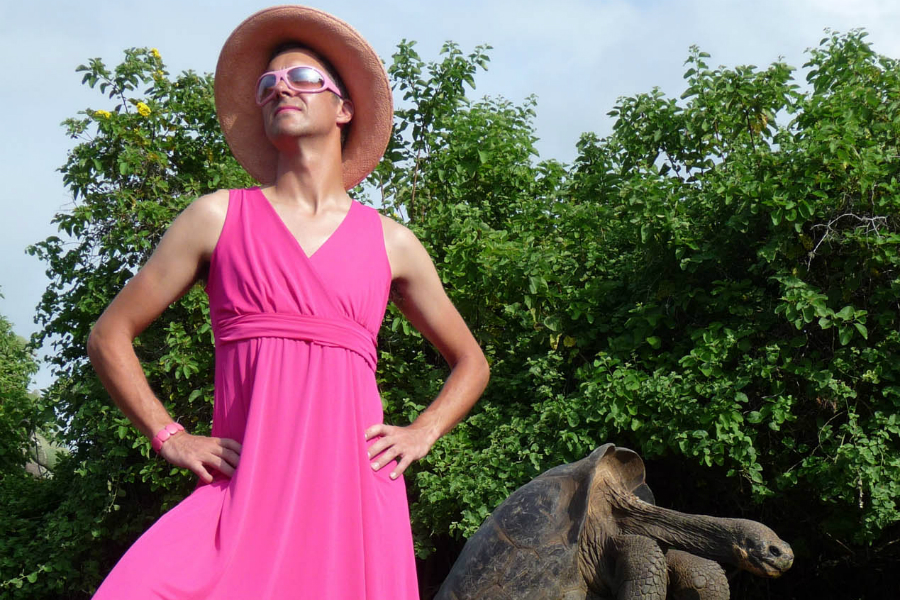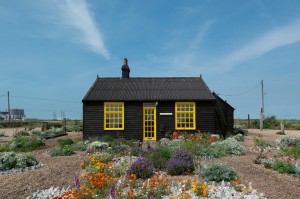The Big Interview Part One: Marcus Coates

“I learned a lot about people, by being a bird.” Andrew Foulds meets Marcus Coates to talk about new exhibition Galapagos, and why he felt compelled to dress as a blue footed booby…
Andrew Foulds – My first question is about your relationship to Liverpool, with your involvement in Further Up In The Air (a residency programme established in the now demolished tower blocks at Sheil Park, Edge Hill), with Liverpool Biennial, and with Walker Art Gallery. Is it fair to say this city has played a fairly significant role in the trajectory of your career?
Marcus Coates – I made Journey To The Lower World in 2004 after I had completed the residency for Further Up In The Air and this was a very significant piece which broke new ground for me. I was only able to do this through the people that I had met in Sheil Park. So much work since then has been based on the experience I had in that block. It was incredibly important for me to see that my practice could be accepted and embraced by the people I met in the tower and on the street as well as in the gallery. The general attitude of the people here seems to be of embracing ideas rather than mistrust and it is very exciting and quite rare as an artist to come across that. Another place which had this was Stavanger which I visited as part of an exchange that happened between Liverpool and Stavanger in Norway.
AF – Am I right in thinking Journey To The Lower World was your first performance?
MC – Yes, it was the first public performance, and the first of that shamanic series I did. It was a trial really, to see whether this type of thing would work and I only ever intended to do one.
AF – Where did this interest in performance begin and are there any artists you could pinpoint as being a particular influence?
MC – There are lots of artists whom I have absorbed during my education and then probably forgotten about, no-doubt over time some have re-emerged subconsciously through developments in my work. The act of performance really came about through my relationship with nature, how I define that relationship and what that means from a wider context, in what I would describe as the humanity of nature. That relationship I feel is a very dynamic, physical thing, when I go out into the woodland or fields that is a performance in itself, just me interacting with animals, grass or whatever it may be. Art is just one step further, it’s having a camera or sound recording equipment and documenting that dynamic. Performance is an extension of that, getting people to see it is another level and that was quite a big step for me.
AF – Do you see yourself as being in character during your performances?
MC – When I do that shamanic work I am Marcus Coates, talking to people and asking them to give me a question to work with. Then when I go on this journey, in my imagination, to this other world, I don’t feel like I am any character. I totally lose myself and become a kind of mutual concept in this other world, so things are just happening to me and I’m not guiding anything or trying to direct anything. It’s totally self-generating, so no, not a character but a more essential, pared down, simple, almost childlike version of myself. When I come back I’m Marcus again and I try to understand and explain that journey for the audience. When I wear a costume, be it a stag, or a badger or whatever animal, that does feed my confidence and get me into a performance mode of being. Equally, there needs to be an element of showmanship, drama, theatre. In that situation you are asking people to believe in something, to trust you and to have a leap of faith to enter into your own personal vision, your own imagination, and that is quite a big leap for people to take. The theatre helps that and it also binds people, focuses their minds. For lots of traditional shamanic cultures, the masks they wear are often as a way of trying to inhabit very specific ancestral spirits. My own work is a self made process loosely based on a traditional ceremony, I tend to go on familiar journeys through landscapes and see animals doing strange things, then try to interpret these actions. I have had to create a symbolic world of animals that I can believe in and that has relevance for me.
AF – Would you like to describe for our readers the work you have in Galapagos?
MC – I have two pieces of work in the show, one is Human Report, a video I made for the local TV news station on Galapagos. It’s a tiny station run by a family and I did a news report for them dressed up as a blue footed booby. I was looking at some of the problems that exist due to the human colonisation of the islands, and coming at it from a bird’s point of view. The other piece I have in the show is called The Great Auk And Its Egg which I made after I came back from the Galapagos and is inspired by species becoming extinct. Once you have lost something it is gone forever, I wanted to look at how we relate to other species to try to ensure that this doesn’t happen again.
AF – Do you think the Galapagos archipelago has a special pull for artists because of the historical, now almost mythical, significance of the place in our culture’s understanding of the world?
MC – Galapagos has always existed to me as a sort of paradise and going there punctured some of that, there’s a lot of problems there. I wanted to explore some of those issues which exist between the human and animal world. Send anyone out to a paradise and the realisation will soon hit home, that paradise doesn’t really exist. Artists are in a very interesting position to talk about how we culturally create places for ourselves. The only reason we create paradises are so that we can live in this world and have somewhere to go in our minds, so a lot of it was about bringing the reality of the Galapagos back here and saying it’s not really what we think it is. It’s more beautiful and wondrous than you can imagine, but it also has its own difficulties and problems that are relevant to us all.
AF – Would you say that you inhabit the animals you take on, or is the process a step removed for you? For example, when you dressed up as the Blue-Footed Booby in Human Report, did you aim to inhabit the mind of the booby?
MC – I don’t know what the character of a blue-footed booby is. We project onto them a comical character because they’re quite funny birds, with bright blue feet and they do a funny dance when they are courting. To us they seem like clowns. What was important to me was that I wasn’t a human, I had to believe I was a bird in order to look at the human habitation of the Galapagos from a fresh position. To be outside of myself, in order to see myself and other humans on the island with a new perspective, with new insights.
AF – You use humour quite a lot. Is this to disarm the participants?
MC – Dressing up as a bird like that, is a comical thing to do, because of this people are drawn to you, they’re curious. It’s not purposefully disarming, more-so it acts as a form of protection for me and also a way of suggesting that I am not here to harm anyone, this isn’t an aggressive activity, please be open with me. I may look funny but I try to make all participants aware that I take this seriously and that they can be serious too. People usually do, which is amazing. The blue-footed booby is an example, people came out of their houses to speak to me, which I have never had before as a tourist. I learned a lot about people, by being a bird.
Andrew Foulds
Galapagos continues at the Bluecoat until 1 July 2012
The Big Interview: Marcus Coates concludes tomorrow…





